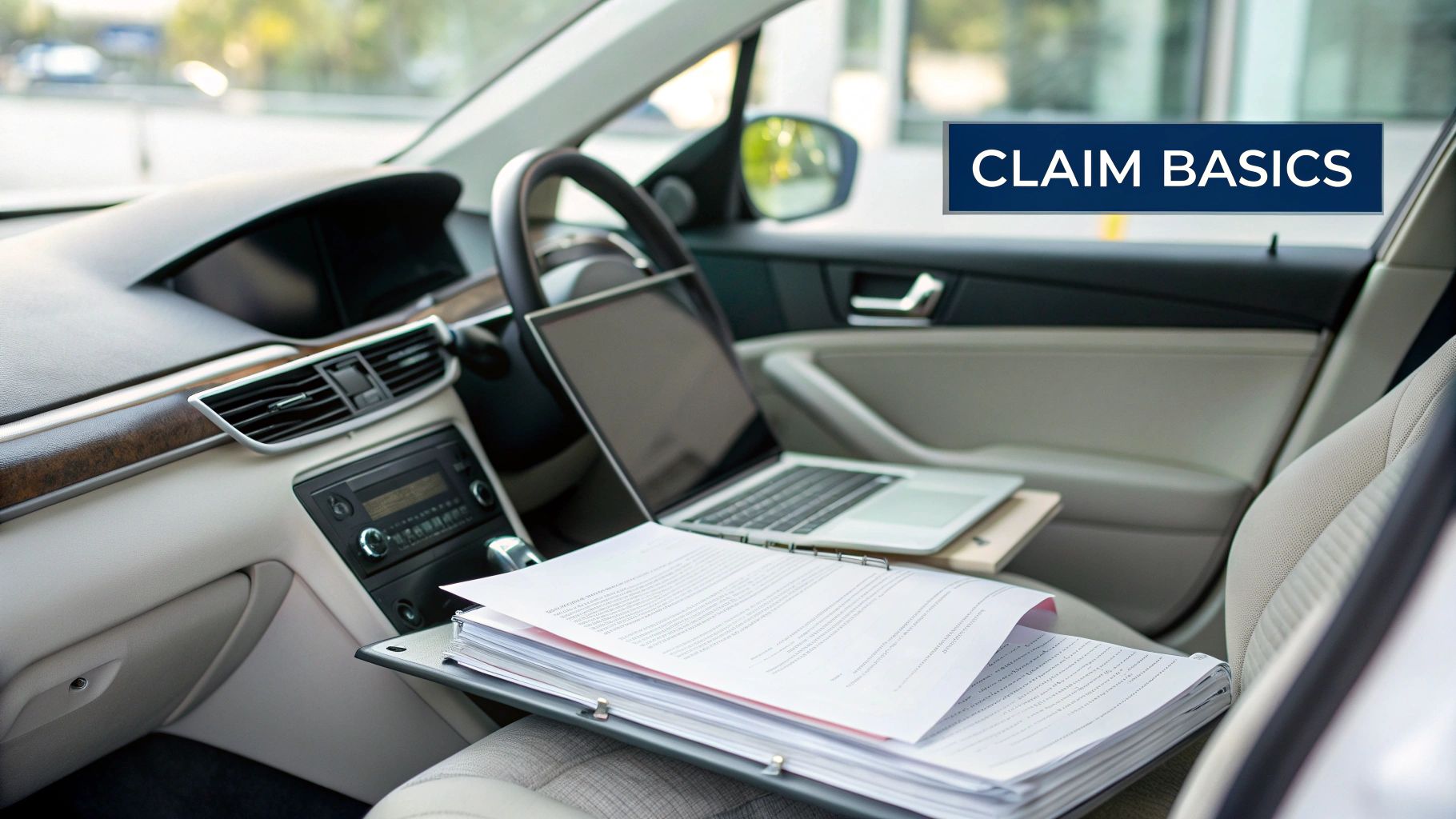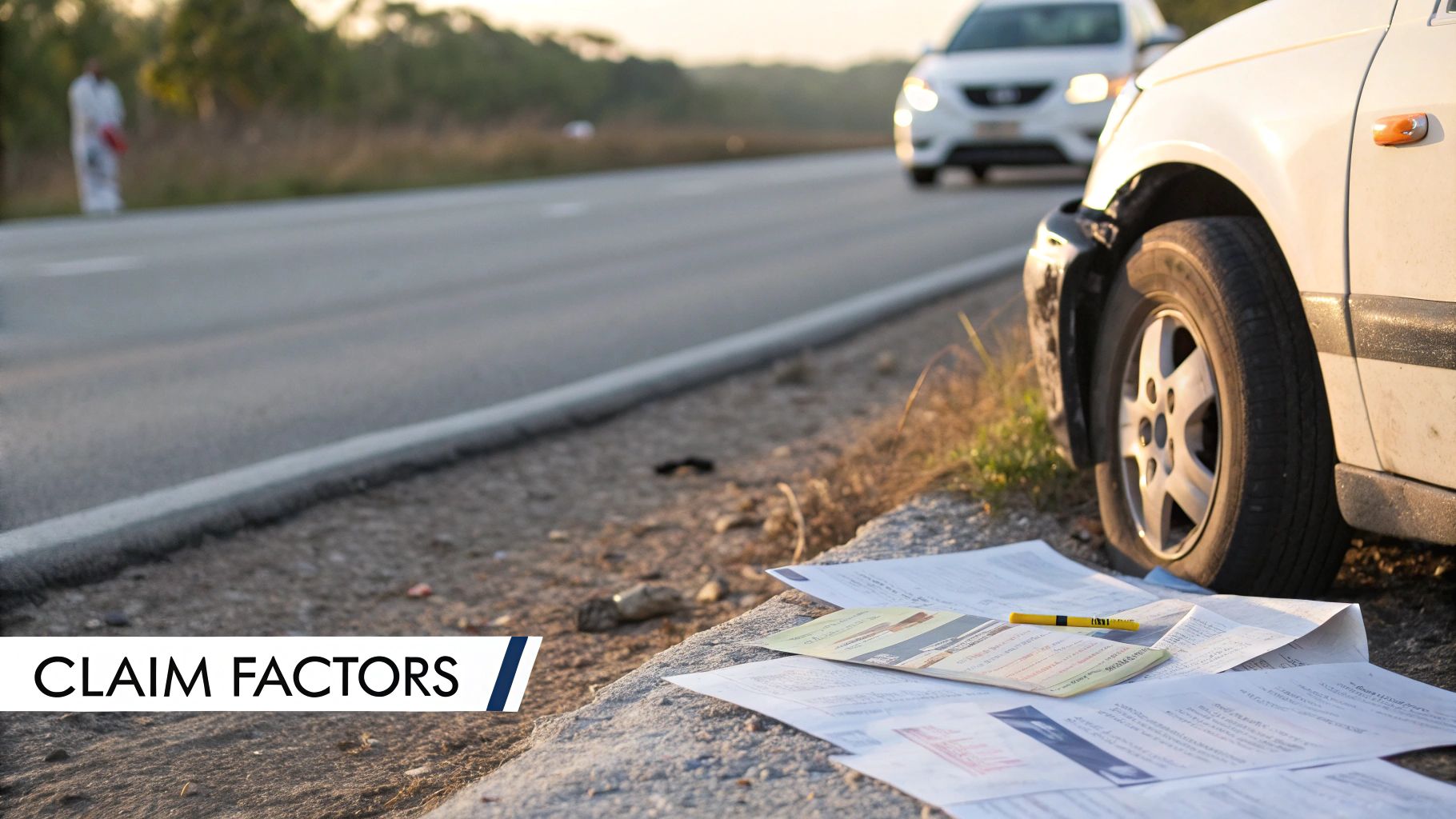Decoding the Modern Car Insurance Claim Landscape

Understanding the average car insurance claim is vital for every driver. This knowledge helps establish realistic expectations and navigate the often-complicated claims process. It also allows you to compare personal experiences with national trends and better understand the factors influencing claim settlements.
Common Claim Types and Their Frequency
One of the first steps in understanding the claim landscape is identifying the most common claim types. This helps illustrate what a “typical” claim looks like. For example, minor fender benders in parking lots frequently lead to property damage claims. Collisions with other vehicles or stationary objects result in collision claims. These two categories often comprise a significant percentage of average car insurance claims.
The frequency and type of average claims offer insights into how often and why policyholders file them. In the U.S., collision claims are the most common. On average, there are approximately 5.8 collision claims per 100 years of insured coverage. Property damage claims follow at 3.7 per 100 years. This data indicates that more than half of all claims relate to vehicle accidents.
The average cost of collision claims for physical damage in the U.S. is also steadily rising. In 2022, the average private passenger auto collision claim reached approximately $5,992. This underscores the financial impact of accidents on drivers and insurance companies alike. For more detailed statistics, visit Bankrate.
Understanding Claim Severity and Payouts
It's important to remember that the cost of claims varies significantly. The severity of an accident directly correlates to the settlement amount. A minor scratch will result in a much smaller payout than a collision totaling your vehicle. This difference in severity is a key factor in understanding what constitutes an "average" claim. The average can be significantly influenced by a small number of very high-value claims.
How Adjusters Categorize Your Claim
Insurance adjusters play a vital role in determining the value of a claim. They categorize your situation based on factors like the type of accident, the extent of the damage, and your policy details. A single-car accident involving a tree is categorized differently than a multi-car collision at an intersection. This categorization influences the claim process and final settlement offer.
Learning more about how various companies handle claims can be beneficial. A resource like The Top Car Insurance Companies of 2025: A Comprehensive Review can provide valuable context for navigating the claims process. This knowledge helps you engage effectively with your insurer and advocate for a fair settlement.
The Financial Reality: What Your Claim Is Actually Worth

Understanding the average car insurance claim involves more than just knowing the national average. It requires a closer examination of the specific factors that influence your personal settlement. This means grasping how insurance companies calculate payouts based on the details of your accident and your individual policy. This knowledge empowers you to navigate the claims process effectively.
Factors Influencing Your Settlement
Several key factors play a crucial role in determining your claim's value. The type of vehicle you drive, for example, is a primary consideration. Luxury cars and SUVs typically have higher repair costs, potentially resulting in larger payouts than those for more economical vehicles.
The accident's circumstances also matter significantly. A single-car accident versus a multi-car collision will have different evaluations, affecting the final settlement. Your policy specifics, including coverage limits and deductibles, also directly impact the amount you receive.
If you have a lower coverage limit, your maximum payout is capped, even if the damages are higher. Your deductible is subtracted from the settlement, affecting your out-of-pocket expenses. These factors combine to create a unique calculation for each claim.
How Insurers Calculate Payouts
Insurance companies use a complex formula to determine payouts. This formula considers the estimated costs of vehicle repairs, medical bills, lost wages, and other related expenses. The process also accounts for who is at fault.
If you are partially at fault, your settlement might be reduced proportionally. Grasping these calculations offers valuable insight into how insurers arrive at their initial offer, allowing you to negotiate effectively.
The financial impact of car insurance claims is extensive. In 2021, U.S. private auto insurance companies faced almost $170 billion in losses. 57% of these losses were from liability claims, and 43% were from physical damage claims, including collision and comprehensive coverage. These claims' processing costs are substantial for insurance companies, affecting both profitability and premiums. Learn more about these statistics at AutoInsurance.com.
Repair Versus Replacement: A Critical Distinction
A crucial decision in the claims process is whether your car will be repaired or replaced. This depends on the damage and the vehicle's market value. If repair costs exceed a certain percentage of the car's value—often around 70-75%—the insurer may declare it a total loss.
This means they'll pay you the car's market value, minus your deductible, rather than covering repairs. Understanding this threshold helps manage expectations and prepare for different outcomes. It highlights the importance of accurate vehicle valuation.
To illustrate the varying costs associated with different claim types, the following table provides a breakdown:
Average Car Insurance Claim Costs by Type
A breakdown of typical claim amounts across different coverage types based on recent industry data
| Claim Type | Average Payout | Year-Over-Year Change |
|---|---|---|
| Property Damage | $4,700 | +3% |
| Bodily Injury | $20,200 | +5% |
| Collision | $3,800 | +2% |
| Comprehensive | $1,700 | +1% |
This table uses illustrative average figures. Actual claim payouts vary significantly based on individual circumstances.
As this table demonstrates, bodily injury claims generally result in the highest average payouts, followed by property damage. Collision and comprehensive claims tend to have lower average costs. Understanding these general trends can be helpful when assessing the potential value of your own claim.
The Premium Impact: What Happens After You Claim

Filing an average car insurance claim affects more than just your immediate expenses. It can significantly impact your future premiums. This section explores how different claim types affect your insurance costs and suggests ways to minimize the financial consequences.
How Claims Affect Your Premiums
Insurance companies use algorithms to assess risk and determine premiums. Filing a claim, even if it's not your fault, can indicate increased risk to the insurer. This can result in a premium increase when your policy renews. The size of the increase varies based on several factors: the type of claim, the claim amount, and your driving history.
Claims involving serious accidents or substantial property damage usually lead to higher premium increases compared to minor fender benders. Multiple claims within a short period can drastically increase your premium.
Claim Types and Their Impact
Different types of claims are viewed differently by insurers. Some claim types lead to greater premium increases than others. At-fault accidents usually have a bigger impact than not-at-fault accidents because they suggest a higher risk of future incidents.
Comprehensive claims, like those for weather damage or theft, typically have a smaller effect on premiums than collision claims. This is because they're generally not seen as reflecting driver error.
The Duration of Premium Increases
The impact of a claim on your premiums isn't permanent. However, the effects can last for several years, depending on your insurer and the details of the claim. Many insurers use a surcharge system, where a premium increase is applied for a set period, usually three to five years, after a claim.
If you maintain a clean driving record after this surcharge period, your premiums should gradually return to pre-claim levels. Multiple recent claims can extend the surcharge duration.
Minimizing the Financial Impact
While sometimes filing a claim is unavoidable, there are ways to lessen its financial impact. One key tactic is understanding your deductible. If the repair cost is close to or less than your deductible, paying out-of-pocket might be more cost-effective. This avoids a claim on your record, preventing a potential premium increase.
Another strategy is to maintain a solid driving record. Many insurers offer discounts to drivers without accidents for a specified number of years. These discounts can offset future premium increases from a potential claim.
When to File vs. Pay Out-of-Pocket
Deciding whether to file a claim or pay out-of-pocket requires careful thought. Compare the upfront cost of repairs to the potential long-term cost of increased premiums. If the premium increase over several years is greater than the repair cost, paying out-of-pocket is often better, especially for minor incidents.
This proactive approach can save you a significant amount of money over time. However, if the damage is extensive, filing a car insurance claim becomes necessary despite the potential premium increase. Understanding these considerations allows you to make informed choices and effectively manage your insurance expenses.
Navigating the Claims Process Like an Industry Veteran

Understanding the car insurance claim process is crucial for a smooth experience. This section breaks down the key stages, from the initial 24 hours after an accident to the final settlement, empowering you to navigate your average car insurance claim with confidence.
The First 24 Hours: Critical Steps
The immediate aftermath of an accident is the most critical period for a successful claim. Your first priority is ensuring everyone's safety and contacting emergency services if needed. Thorough documentation of the scene is paramount. Take photos and videos of vehicle damage, the accident location, and any visible injuries.
Gather information from everyone involved, including names, contact information, insurance details, and witness statements. Even for seemingly minor accidents, promptly reporting the incident to your insurance company is essential for initiating the claims process efficiently.
Working with the Adjuster: Insider Tips
Once you've reported the accident, an insurance adjuster will be assigned to your case. The adjuster investigates the accident and determines the amount the insurance company will pay. Effective communication with the adjuster is vital for a smooth process.
Keep clear, accurate, and concise records of all your interactions. Be prepared to provide any additional documentation the adjuster requests, such as medical bills and repair estimates. Understanding the adjuster's role and maintaining professional communication can help expedite the claim.
Documentation Priorities: Building a Strong Case
Thorough documentation forms the foundation of any successful average car insurance claim. Organize all documents related to the accident, including police reports, medical records, repair estimates, and correspondence with the insurer. This organized approach not only ensures easy access to vital information but also strengthens your position. Proper documentation can significantly influence the adjuster's evaluation and the outcome of your claim.
Negotiation Strategies: Maximizing Your Settlement
After the adjuster completes their investigation, they will make an initial settlement offer. Don't feel pressured to accept the first offer. Research the fair market value of your vehicle and any related expenses, such as medical bills and lost wages.
Use this information to justify a higher settlement if necessary. Negotiation is a normal part of the process, and a well-informed approach can help you maximize your claim’s value.
Troubleshooting Common Roadblocks
The claims process isn't always straightforward. Delays, disputes, and disagreements can occur. If you encounter difficulties, contact your insurance company's customer service department for assistance. If issues persist, consider seeking legal advice. You might also find helpful resources online, such as this article on How to master the car insurance claim process. Being proactive in addressing challenges can prevent small issues from escalating into major problems.
Recognizing Adjuster Techniques
Insurance adjusters often employ specific tactics during the claims process. Lowballing, offering a significantly lower settlement than the claim's likely worth, is a common tactic. Being aware of this can help you navigate negotiations more effectively.
Another technique is the use of delaying tactics, prolonging the process to potentially frustrate claimants into accepting lower offers. Recognizing these strategies empowers you to respond strategically. By being prepared and understanding the process, you can become a proactive participant, equipped with the knowledge to navigate the insurance claim process successfully and improve the likelihood of a fair settlement for your average car insurance claim.
The Technology Revolution Reshaping Insurance Claims
Technology is rapidly changing how we handle car insurance claims. This presents both exciting opportunities and potential challenges for policyholders. Understanding how these advancements impact your average claim is more important than ever.
How Technology Is Transforming Claims
Artificial intelligence (AI), telematics, and mobile technologies are transforming claim evaluations. AI-powered systems can quickly analyze accident data, often gathered through mobile apps at the scene, to generate initial damage assessments. This can streamline the process. However, it also raises questions about the accuracy and potential biases in automated systems.
Telematics, the use of devices to monitor driving behavior, plays a growing role. Insurers use telematics data to reconstruct accidents, assessing factors like speed and braking to help determine fault more accurately. While leading to more precise evaluations, this technology also raises privacy considerations for drivers.
Mobile technologies empower policyholders to submit claims quickly through apps, often including photo and video documentation. This significantly speeds up the claims process. Some insurers are even using virtual inspections. Claimants upload photos or videos of the vehicle damage, eliminating the need to wait for an in-person appraisal. This can drastically reduce processing times, leading to faster settlements.
The Benefits and Pitfalls of Digital Claims
Faster settlements are a key benefit of these technological advancements. Virtual inspections, for example, can dramatically reduce payout times. Claim types like those with minor damage or single-vehicle accidents especially benefit from these streamlined processes. However, these technologies can also introduce new challenges.
One concern is the potential for digital missteps. Claimants might submit incomplete or inaccurate information through mobile apps. Increased reliance on digital communication can sometimes create misunderstandings or reduce personal interaction with adjusters.
The global insurance claims services market, including car insurance claims, is influenced by several factors. Increasing road accidents and ongoing technological advancements are chief among them. The market is projected to reach $345.97 billion by 2029. This growth is partly fueled by a rise in accidents, urbanization, and the adoption of technologies like AI and cloud-based claims solutions. Learn more about insurance claim market growth.
Leveraging Technology to Your Advantage
Despite potential downsides, understanding how technology is used in the claims process can benefit policyholders. By familiarizing yourself with these tools and techniques, you can strengthen your position during a claim.
This means understanding how to:
- Gather and submit digital evidence effectively
- Communicate clearly through online platforms
- Know when to seek clarification or assistance
Technology is reshaping the average car insurance claim, creating both opportunities and challenges. By staying informed, you can make the most of these advancements and ensure you're prepared for the future of insurance claims.
Maximizing Your Settlement: Proven Strategies That Work
After an accident, securing a fair car insurance claim settlement is a top priority. This goes beyond simply filing paperwork. It requires a strategic approach to maximize your potential recovery.
Documentation: Your Foundation For Success
Detailed and accurate documentation is essential. This includes photos and videos of the accident scene, vehicle damage, and any visible injuries. Gather information from everyone involved, including witnesses. Police reports, medical records, and repair estimates are also vital components of a strong claim.
This comprehensive documentation paints a clear picture of the incident and its effects, strengthening your negotiating position.
Understanding Adjuster Psychology
Insurance adjusters are trained professionals with specific objectives. Understanding their tactics is crucial for maximizing your settlement. They might initially offer a lower amount than your claim is worth, hoping for a quick acceptance.
Knowing this common tactic empowers you to negotiate more effectively. Adjusters may also employ delaying tactics. Be prepared for these and remain persistent in pursuing a fair settlement. Organized and proactive communication can counteract these strategies.
Effective Negotiation: The Art of Persuasion
Negotiation is a key part of the claims process. Don't feel pressured to accept the first offer. Research the fair market value of your vehicle and related expenses, like medical bills and lost wages.
Use this information to justify a higher settlement if the initial offer is insufficient. Present your case clearly and confidently, using your documentation as evidence. This demonstrates you’re serious about receiving a fair settlement, increasing your likelihood of a better outcome.
Expert Assistance: When To Seek Help
While you can handle many claims independently, some situations benefit from professional help. If your claim involves serious injuries, complex legal issues, or disputes with the insurance company, consulting a personal injury lawyer can be invaluable.
They can offer expert advice and negotiate on your behalf, potentially leading to a much higher settlement. You might find Ranking the Best Car Insurance Providers of 2025 a helpful resource during the claims process.
Escalation Versus Settlement: Knowing When To Push
Knowing when to escalate your claim versus accepting a settlement is crucial. If negotiations stall or the insurer refuses a fair settlement, you might need to escalate. This could involve filing a formal complaint with your state’s insurance department or pursuing legal action.
Carefully weigh the potential costs and benefits of escalation. Sometimes, a slightly lower settlement is more cost-effective than a protracted legal battle.
Evaluating Initial Offers: A Practical Framework
When you receive an initial offer, take time to evaluate it objectively. Compare it to your calculated damages, including vehicle repairs, medical expenses, lost wages, and pain and suffering. If the offer significantly undervalues your claim, be prepared to negotiate.
Consider factors like the strength of your documentation and the likelihood of success if you escalate. This analysis helps you decide whether to accept, negotiate, or escalate the offer. To better understand how these factors interplay, let's review the table below:
To illustrate how various factors can affect your claim outcome, the following table provides a helpful comparison:
Claim Settlement Success Factors
| Factor | Positive Impact | Negative Impact | Optimization Strategy |
|---|---|---|---|
| Documentation | Supports claim validity, strengthens negotiating position | Weak documentation can undermine your case | Meticulously gather all relevant evidence, including photos, videos, and witness statements. |
| Adjuster Interaction | Positive rapport can facilitate a smoother process | Antagonistic interactions can hinder negotiation | Communicate clearly, professionally, and respectfully with the adjuster. |
| Negotiation Skills | Ability to present a compelling case maximizes settlement value | Poor negotiation can lead to accepting a lower offer | Research comparable claims and practice your negotiation strategy. |
| Expert Assistance | Legal counsel can provide valuable guidance and advocacy | Cost of legal representation can reduce net settlement | Seek legal advice if your claim is complex or disputed. |
By understanding and implementing these strategies, you can significantly improve your approach to car insurance claims. This proactive approach empowers you to navigate the claims process effectively and maximize your potential settlement.
Comments are closed.